Zone Offense in Basketball: Concepts, Plays & Teaching Strategies for Coaches
If you coach long enough, you’re going to see zone defenses—2-3, 1-3-1, 3-2, and everything in between. And whether you're coaching 5th grade or varsity, one thing is true: if your team doesn't understand how to attack a zone, your offense will stall out, shots will get forced, and good possessions will go to waste.
That’s why this page exists—to give you a simple, effective framework for building a zone offense that works at any level. Here, you’ll find:
- Core concepts that help your players read and react vs. any zone
- Zone offense plays designed to create high-percentage shots
- Drills and teaching tips to build habits your team can rely on
- Adaptable strategies you can plug into whatever system you already run
Zone offense doesn’t have to be complicated. In fact, the best zone attacks are often built around a few clear principles—spacing, ball movement, inside touches, and player movement. Once your players grasp these ideas, they’ll know how to create scoring opportunities no matter what kind of zone they face.
Whether you're teaching young kids to move without the ball, or looking for a few set plays to use in a varsity game, you’ll find what you need here.
Let’s break it down and give your team the tools to thrive against any zone defense.
Contents
7 Questions To Guide Your Zone Attack
Zone Offense Teaching Strategies
Zone Offense Basketball Drills
Zone Offense Comprehensive Resource
7 Questions To Guide Your Zone Attack
Here are 7 questions to help you prepare for whatever zone you face:
-
What’s the formation?
This should be the starting point of your scouting. Is it an even front or odd front zone? Beyond that, if even front, is it a 2-3? 2-1-2? If odd, is it 1-3-1? 1-2-2? 1-1-3? 3-2? Knowing the formation gives you your first clue of how to attack.
-
How aggressive is it?
Every zone can be played aggressively or conservatively. Some 1-3-1 defenses trap and scramble. Some pack it in. Don’t assume you know the aggressiveness level based on the formation. Scout that separately.
-
How far do they extend the zone?
Once again, this is different from aggression. A zone could pick up close to half court and simply force you to start your offense higher. This doesn’t necessarily mean it’s aggressive.
One thing to avoid is allowing a zone to force your offense too far from the basket. If you're playing an opponent who extends their defense, you’ll need to come up with some ways to get the ball into scoring areas.
-
Do they trap? And, if so, where?
Some zones never trap. Others trap regularly. It’s critical to know what category your opponent’s zone falls into.
If they do trap, where do the traps occur? For some, that will tell you areas you want to avoid. For others, you may quickly bring the ball there and then attempt to beat the trap and create an advantage.
-
Is it their primary defense or do they use it as a change of pace?
This question can guide the amount of time you put into preparing for the zone. Do they play it all the time or only occasionally?
If occasionally, are there patterns as to when they play it? For example, Kevin Furtado likes to use The Buzz Defense - A Half Court Trapping Defense in the 3rd quarter, giving opponents less time to adjust to it.
If you can find a pattern to when they use it, you’ll be better prepared for it come game time.
-
Where is it vulnerable?
Every defense (man or zone) has vulnerabilities. Knowing them and exploiting them are key. Is their zone weak in the middle? Is it weak against an overload. Are the corners open? Do they struggle to box out?
Once you see where good shots are coming from, you can tailor your attack to focus on those areas.
-
How do they guard the middle?
Getting the ball into the middle is a goal against almost every type of zone. This often happens by passing the ball to the high post. However, it could also be through dribble penetration.
As you prepare, watch how they guard the middle and then figure ways to counter.
If you want a FREE PDF of these 5 plays, plus 2 bonus plays, click the banner below!
Zone Offense Concepts
Zone defenses give a lot of teams headaches. The ball gets stuck, players stand around, and eventually someone jacks up a contested three. But it doesn’t have to be that way.
In fact, zone offense is a great way to show your coaching bonafides. Against man to man, players with elite ball skills can cover for a lot of coaching shortcomings. Against a zone, your players need to understand effective zone offense concepts in order to thrive.
Yes, it’s important to have some plays ready when you face a zone defense. Those are great for a couple of possessions. But what do you fall back on after you’ve used your best sets?
Do you just “trim the hedges” and pass the ball around the perimeter without putting any pressure on the defense?
Not anymore! Check out these 5 zone offense tactics from championship coaches at the high school, college, and olympic levels!
Zone Busters: 5 Smart Concepts For Every Team
1. Utilize the Core 4 Elements
As Coach Don Kelbick says, you need four ingredients in any zone possession: a strong side threat, weak side threat, post presence, and ball reversal. When all four are active, the zone is constantly shifting—and that’s when mistakes happen. Without these, your offense gets predictable and easy to guard.

In this example, 2 is the strong side threat. 4 is the post threat. 3 is the weakside threat. 1 or 5 (if you popped them to the perimeter) could be reversal options.
Each element offers some flexibility. 2 could be in the corner. 5 could be on the perimeter.
There are multiple ways to fill the 4 spots. Just make sure you do so!
2. Use Ball Screens vs the Zone
Yes, you can screen a zone. In fact, you should. Set a ball screen and force defenders to make decisions. You’re looking to create gaps, distort the coverage, and get downhill into the kill zone or force a mismatch on the back side.
As 10x Gold Medalist Don Showalter points out, Screens don’t just work in man—they work in zone too when you set them with purpose.
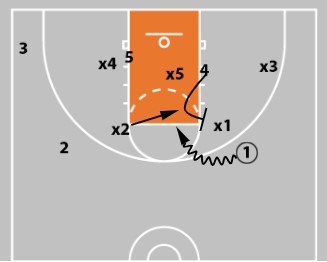
Unlike in man to man, zone defenses usually don’t have 2 players covering the ball screen. That means a defender has to move out of their zone to stop the player with the ball (x2 above).

This creates an advantage in the area that defender vacated. Here 1 passes to 2. 2 should be open for a shot. If x4 steps up, 2 can make the extra pass to 3 in the corner (who would be the strong side threat in this example - see concept #1).
3. Screen and Seal Inside
You don’t need complex actions—just teach your bigs to seal defenders and screen the zone from the inside. A good seal can create a wide-open post feed or open up perimeter shooters.
As Matt Lewis points out, it’s especially effective when players learn to flash, seal, and reposition based on where the ball is moving.
Many teams play zone defense because they don’t feel like they can guard you inside. Don’t allow them to take that away.
A lot of zone plays look to screen and seal inside defenders. You should have plays that do that. More generally, coach your post players to look to seal on reversals. They can usually get good post position close to the rim.
4. Flash to Open Spots
This is motion offense 101: fill spots, stay active, and confuse the zone. That’s why Bob Martin is able to use a similar attack against man and zone with his Screening Game Offense.
Attack from the elbows, blocks, and short corners—then teach your players how to flash to the high post, dive to the baseline, and constantly move behind the zone. Players don’t need to memorize plays—they need to understand spacing and movement.
While this sounds obvious, it’s not. Many players who are positioned at the high post stand in one spot. They allow themselves to be denied. Players must find and move to open areas.
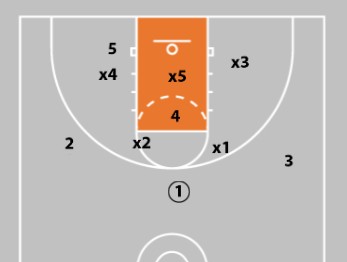
In the short corner, that might even be behind the backboard. Staying behind the zone taxes the backline defenders who can’t see all 5 offensive players (see player 5 above)
5. Beat Traps Through the Middle
Zone traps are designed to disrupt your rhythm—not just steal the ball. The best way to beat them? Use the middle of the floor. Flash a player to the high post as your ball reversal option, then kick opposite. Maintain your spacing, don’t panic, and keep flowing into your offense. The trap will collapse if your players keep their discipline.

Don Kelbick often has a post player flash middle when they see a teammate being trapped. It’s up to you where you want the player to flash from. What’s critical is that players know to get middle and look middle when traps are coming.
Unlock Your Zone O With Simple & Straightforward Strategies
Effective zone offense isn’t based on intricate plays or offenses. It’s based on the repeated execution of the 5 concepts above.
It’s one thing for you to know and understand them. What separates the best teams and coaches is they have players who understand them.
Use them as a checklist for your zone offense and you’ll have teams begging to guard you man to man!
Zone Offense Plays
5 Plays To Punish A 2-3 Zone
When Rick Pitino was at Louisville, he played a lot of zone.
I remember watching an interview with him and he was asked about his new defensive philosophy. He had always been known as a coach who liked to press and play aggressive man to man defense.
Something from his answer stuck with me. He said a major reason that he was playing zone was because it made his game prep easier.
When coaching man to man defense, there are countless actions and offenses opponents can run. Against zone, there are a few actions you see over and over again.
I think there’s some truth to that. There are only so many zone offenses.
If you rely solely on your zone offense, you might end up taking the shots your opponent wants you to take.
And that’s why it’s important that you have some plays you can go to that will get you a great shot against a zone.
Check out our YouTube video “5 Plays To Punish A 2-3 Zone” and the diagrams below to make sure you’ve got a bucket in your back pocket when you need one most!
Play #1 - Chin
Source - Aaron Jennings Princeton Offense System
Chin is a staple of the Princeton offense. That said, it’s also effective against zones! There are two primary scoring options. The first is passing to the 5 after they set the back screen. The second is dribbling up from the wing, which lifts the bottom defender. This opens up the corner for the guard filling out.

-1 passes to 2. As that pass happens, 5 comes up to the elbow.
-2 immediately reverses the ball to 4.
-5 backscreens for 1. After the backscreen, 5 cuts to the ball side high post.

-4 looks to 5 in the high post (or 1 at the rim).
-If x5 comes up, 5 looks to hit 1 behind the defense.
-If x5 stays low, 5 should shoot.
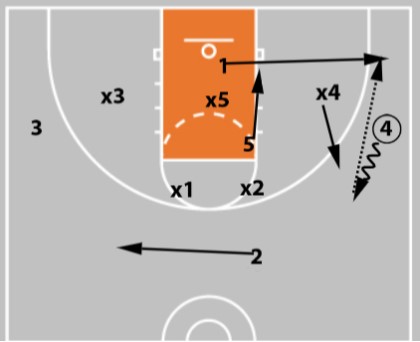
-If 5 is not open, 4 dribbles up.
-4’s dribble cues 1 to fill the ballside corner and 5 to dive.
-4 looks behind them to 1 in the corner. 1 can shoot if x4 has lifted. Or 1 can look to 5 at the rim.
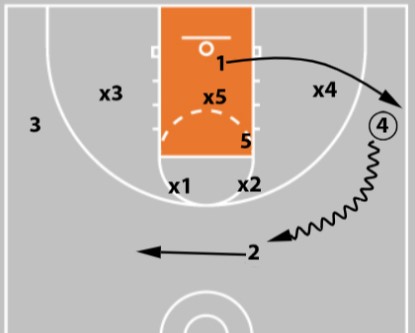
-If nothing is open, 4 continues dribbling to the ballside slot.
-2 bumps over
-1 fills the wing.

-The offense is back in the original formation and can repeat the action on the other side.
Play 2 - Runner/Runner Pin
Source - Uptempo Basketball System With Keith Haske
Most zone offenses teach players to get in gaps. This is a sound principle, as it makes 2 players guard one. However, matching up with the zone can work. It makes screening actions more effective and allows the offense to create matchups that give them an advantage. Runner and runner pin do exactly that.
Runner

-The play starts in a 2 guard front.
-The best shooter starts in the opposite corner (3).
-3 runs the baseline, receiving a screen from the ballside forward (5). 1 passes to 3.

-If x4 can’t get through 5’s screen, 3 should shoot.
-After screening, 5 goes and seals x5 for a post entry.
-4 flashes to an open area in the high post.

-If no options are open, 3 reverses the ball to 1. 1 immediately passes to 2.
-4 returns to their original side.
-3 runs the baseline again, receiving a screen from 4.
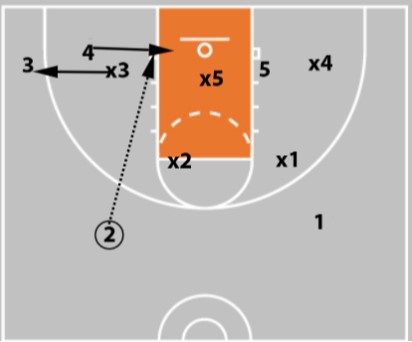
-If 3 is a good shooter, x3 may try to fit over the screen to take away the shot.
-If that happens, 2 can fake a pass to 3.
-4 should step into the gap created by this for a pass at the rim.
Runner Pin
Runner Pin is a great counter to Runner.
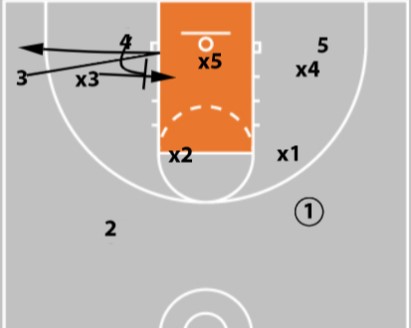
-The play begins the same way.
-3 begins to run through. However, 3 stops and reverses direction.
-4 screens in 3.
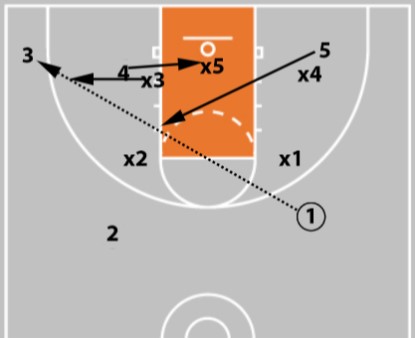
-1 throws a skip pass to 3.
-4 seals x5 at the rim.
-5 flashes to an open area in the high post.
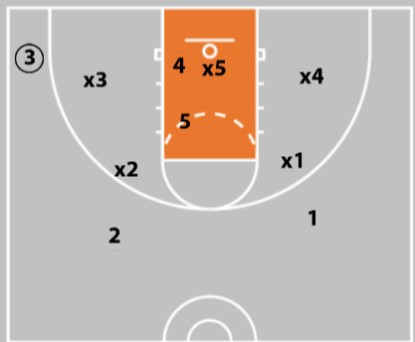
-3 can shoot if open.
-If 3 can’t shoot, they should look at 4 sealing or 5 flashing.
Play 3 - Iowa
Source - The Relentless Pressure System With Mike Hilmer
Most coaches think of ball screens as a tool to use against man to man defense. They are also effective against zones. They allow you to create overloads and numerical advantages create stress for a2-3 zone. Iowa creates a 2v1 advantage against the wing defender.
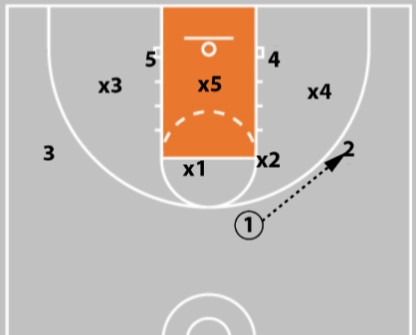
-The offense starts in a 1-2-2 set.
-1 passes to 2 on the wing.
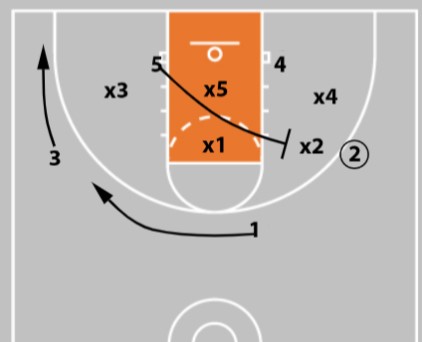
-5 comes across and sets a middle ball screen for 2.
-1 relocates to the opposite wing.
-3 relocates to the corner.

-2 comes off the ball screen and attacks the paint.
-If x1 stops 2’s drive, 2 looks to 1.
-1 can shoot if open. If x3 comes up, 1 looks to 3.
-4 stays opposite for rebounding position
-5 rolls
Play 4 - Walker
Source - The Relentless Pressure System With Mike Hilmer
Walker is a great complimentary play to Iowa. If you have a 5 who can make shots, it’s a must add! Instead of creating the 2v1 in the direction of the screen, Walker creates the same advantage behind the screen.
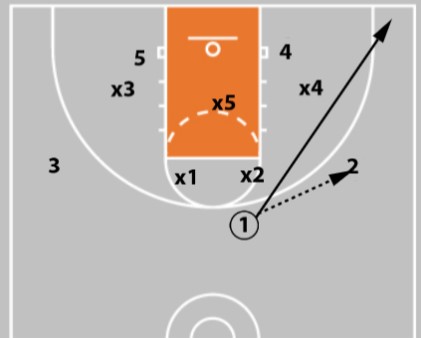
-The offense starts in a 1-2-2 set.
-1 passes to 2 on the wing.
-1 cuts through to the ball side corner

-5 comes up and sets a ball screen for 2.
-4 moves behind the defense to the opposite block
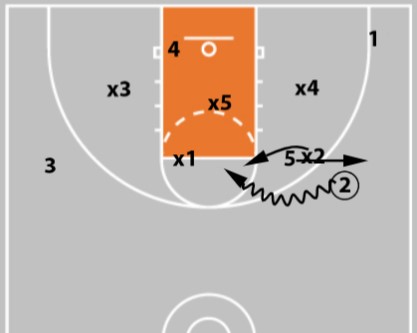
-2 uses 5’s screen and attacks the free throw line.
-After screening, 5 pops out to the wing.

-2 looks to throw the ball back to 1. This creates a 2v1 with 5 & 1 v x4.
-If x4 stays low, 5 should shoot.
-If x4 comes up to guard 5, 5 should pass to 1 who will be open in the corner.
Play 5 - Flare/Slip
Source - The Hybrid Attack Offense With Ryan Schultz
Off the ball screens can be effective against zones too. The flare/slip action puts 1 zone defender in the position of having to decide which action to guard.
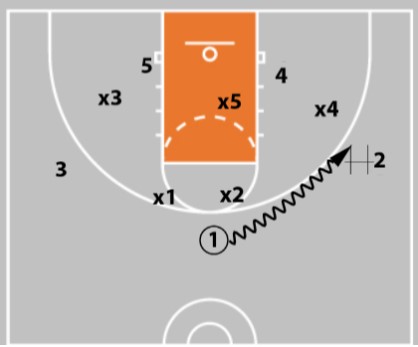
-The offense starts in a 1-2-2 setup.
-1 dribbles at 2 for a dribble hand off.

-After receiving the handoff, 2 dribbles towards the slot.
-3 fills the opposite slot. 2 passes to 3.
-1 runs off a stagger screen from 4 & 5.
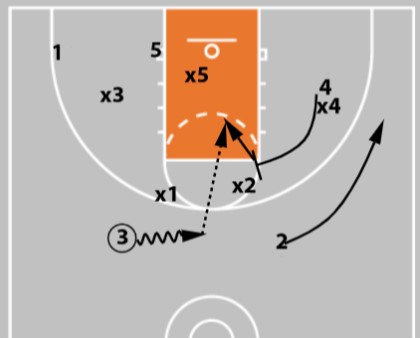
-After screening for 1, 4 comes back and sets a screen on the outside of x2. This creates space for 2’s flare.
-After setting the flare, 4 slips into an open area in the middle.
-3 dribbles middle and reads what’s open.
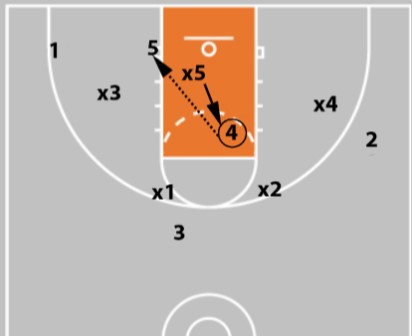
-If x5 steps up to take 4, 4 should look to 5 behind the defense.
If you want a FREE PDF of these 5 plays, plus 2 bonus plays, click the banner below!
More Zone Offense Plays
-
Click the image below to check out our Beating The Zone ebook, which features 75 plays that beat zone defenses!
-
Basketball Zone Plays - Dynamic Zone Offense Plays Against Any Zone Defense
Zone Offense Teaching Strategies
- 7 Simple Tips To Improve Your Zone Offense
- 3 Simple Strategies to Attack a Zone Defense
- A Strange Way To Improve Your Zone Offense
- Using the Flex Offense Versus a Zone Defense
- Yo Yo - Zone Offense
- Breakthrough Basketball:2-1-2 Zone Offense
- 2-3 Zone Offense Tactics From The Wing & High Post
Zone Offense Basketball Drills
- Passing and Decision Making Drill - No Dribble 3 on 2
- Ultimate Passing
- 3 In a Line Toss Drill
- 3 on 3 Trap Drill - Improves Passing and Defense
- 10 In A Row Passing Drill - Mike MacKay
Zone Offense Against 1-3-1 Defense Resources
- 1-3-1 Continuity Zone Offense With Counters
- Sean Miller's Way to Attack the 1-3-1 Zone Defense
- Zone Offense Tip - How to get lay ups against a 1-3-1 zone defense



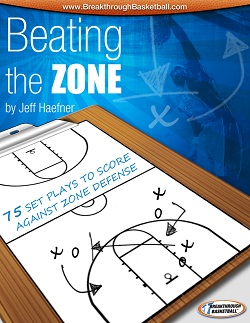

 Facebook (145k Followers)
Facebook (145k Followers) YouTube (152k Subscribers)
YouTube (152k Subscribers) Twitter (33k Followers)
Twitter (33k Followers) Q&A Forum
Q&A Forum Podcasts
Podcasts